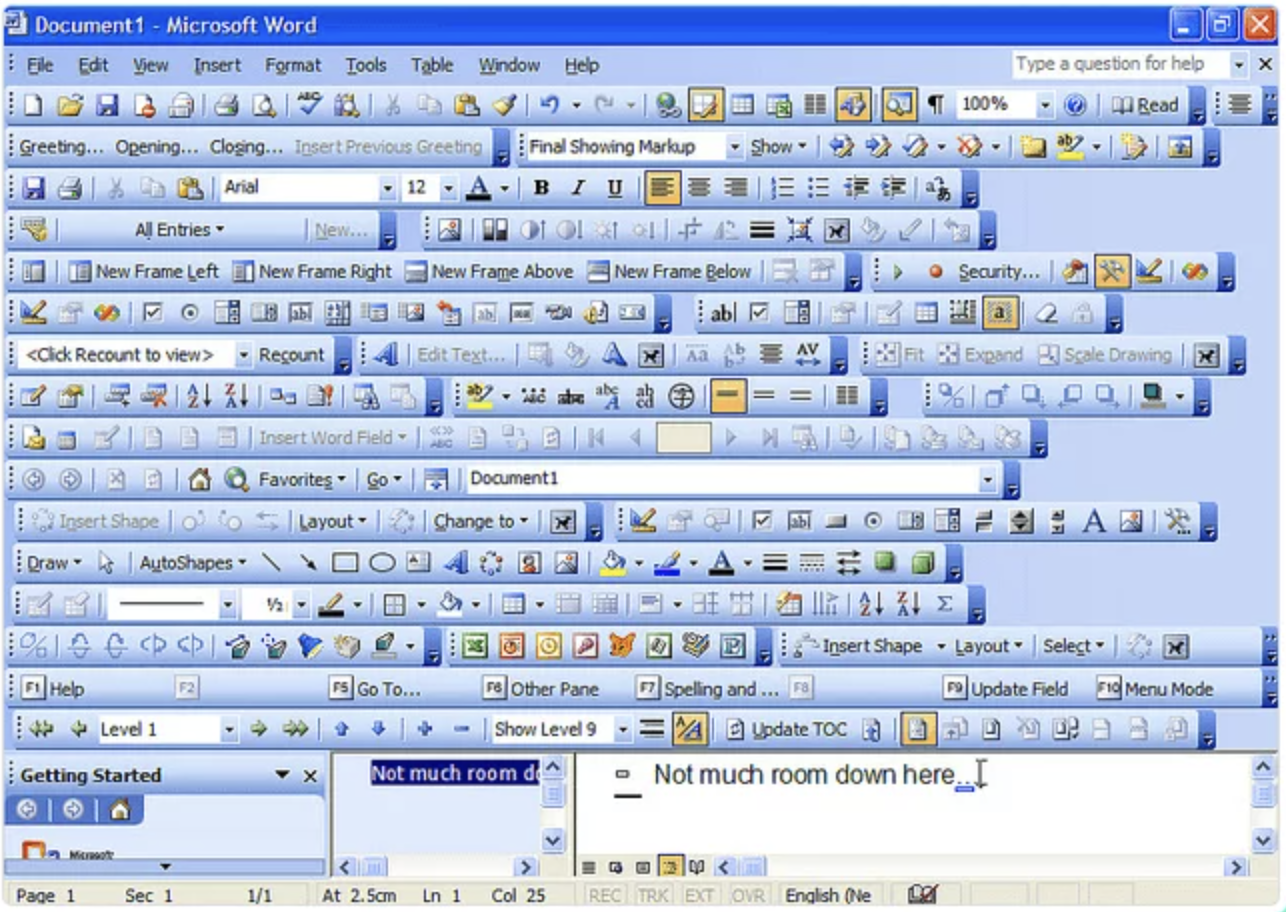
Killing features is a crucial part of software development. Over time, features can creep your project and hide the core value proposition of your product. You need discipline and methodology to scope your project and decide whether to keep or kill features.
Retiring features is as much important as adding them.."A great product is one that solves the customer’s problem in the simplest way possible. Great products deliver value, not features." — Grant Ammons
That might sounds like common sense but creating a simple and intuitive product is hard. If you find a product simple, it's probably because killing features is a part of their concerns.
Feature creep
It was David Pogue who brought it into the spotlight back in 2006. To illustrate he took a screen shot of Microsoft Word with all the available menus.

It confronts how complicated the product really is. Knowing all the options would take ages, not to mention the visual stress if you were to use many options.
Market, business strategy, user behaviours and technologies impact a product. Because of these changes, the product we first envision to solve a specific need start to grow, extending the scope. As the time goes, we add more and more requirements and features to the product.
Any additional feature added to the product increase the learning curve, put stress on navigation and ultimately work against the user.
Controlling the scope
Defining boundaries and maintaining a cohesive vision, is one of the hardest things to do with product development. CEO vision, inventors, acquisitions, new markets are among many business actions that may impact a product boundaries. Where lots of companies see the opportunity to embrace new features while expanding the product scope, few are willing to kill features while reducing that same scope.
"The dilution effect is why maintaining a clear vision for your product is so important. Without a clear understanding of the limits and boundaries of your product, the product will morph into something you no longer recognize. Or worse, something you can no longer manage or control." — Jason Fried
Inherited from the development phase, the backlog is observed chronologically. New feature feels more appealing than older ones. The bad news is, older features are the core value proposition of the product. You have to see your product as a set of features and control it.
Features on the backlog need the same level of scrutiny, or higher. Any increase in the surface area of a product is a potential dilution of the value proposition and the overall experience.
Don't lose sight of the product promise.
How to manage user needs that fall out of our boundaries but can add value to the users?
To answer this question we need to clarify what being "user oriented"
means and how to gather real needs.
A common misconception about being "user oriented" is to think that
interviewing users and answering to there needs with new features is the
solution. Gathering needs only through interview will lead you to what's
Ian Batterbee called "feature-led experiences".
Users are not good at expressing theirs needs.
Observation and data is key when it comes to understand you users.
Be data driven
In order for your product to deliver value, you need to build a framework to review objectively features. Gathering usage data on every feature is a key step to success. We need metrics thar are clear indications of success/failure of a feature. Here, I'm only gonna scrape the surface of two well known systems:
- Dave McClure's AARRR Framework Metrics
- Google’s HEART Framework
McClure's AARRR Framework Metrics
10 years ago David McClure Dave whose an angel invertor, a venture capitalism and a founder of startups created the AARRR framework. He created this framework to measure a startup gross using 5 key performance indicators.
Acquisitions — How do customers find you?
Which channel: Most traffic? / Best conversion rate? / Best cost per acquisition?
Activation — How quickly can you get your customer's to the 'Aha-Moment'?
This is when the user sees the value of your product. Find this moment thanks to customer interview and metrics.
- for apps, that can be after people download / sign up
- for e-commerce, it could be the number of orders.
- for SaaS, sign up for your trial
Retention — How many of your customers are you retaining & why are you losing the others.
Make sure your churn rate is smaller than your customer acquisitions.
- for apps, that can be measured following your daily or monthly active users.
- for e-commerce, it could be the number of orders.
- for SaaS, renewing the monthly subscription.
Referral — How can you turn your customers into your advocates
Keep an eye on the Net Promoter Score and Viral Coefficient.Revenue — How can you increase revenue
Make sure that while building your app and add more feature, you look at those metrics to see the impact. You have to identify which metrics your feature is targeted to define whether it is a success or a failure.
Google's HEART Framework
HEART metrics are especially build to measure UX metric. We can see them as a lower level of dataset compared to AARRR.
Happiness — How do users feel about your product?
Happiness is typically measured by user satisfaction surveys, app ratings and reviews, and net promoter score.Engagement — How often are people coming back to use the product?
Engagement can be measured by number of visits per user per week, session length, or a key action, like the number of photos uploaded or songs listened to per user per day.
Adoption — How many people complete the onboarding process and become regular users?
Adoption is measured by number of new users over a period of time or percentage of customers using a new feature.
Retention — What percentage of users are returning to the product?
Retention is measured by churn.
Task success — Can users achieve their goal or task quickly and easily?
Task success is measured by factors like efficiency (how long it takes users to complete the task) effectiveness (percent of tasks completed), and error rate.
Theses frameworks are very important to objectify the success of your product / features. Being data driven saves you from emotional decisions and sentiments. If all the team is aligned with the goals, you're likely to keep a high level of engagement even if you need to kill features.